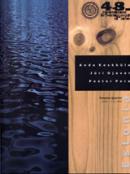ESTONIAN EXHIBITION AT THE 48th VENICE BIENNIAL
12. 06. – 07. 11. 1999
LOCATION:
Palazzo Querini - Fondazione Scientifica Querini Stampalia S. Maria Formosa, Castello 4778, Veneetsia
Estonia’s exposition:
ANDO KESKKÜLA – independent exposition
JÜRI OJAVER, PEETER PERE – curator: Johannes Saar
Commissioner: Sirje Helme
Opening date June 10th, 1999
Exhibited works:

Jüri Ojaver, “Keystone”, site-specific sculpture, 1999
It is a kind of rude attempt to gaze at culture from the point of view of a bored man who still looks at the foxy ladies for no particular reason.

Peeter Pere, “Positsions. MZ 108-04. Makarov. Parabellum”, veneer, 1998
The artistic heritage of Alberto Burri and Lucio Fontana embraces Peeter Pere’s art as European culture embraces Estonian.
Ando Keskküla, “The Breath”, interactive sound and video installation, 1999
Question to a standing man - since when does the body stop acting as the cultural courrier and start to care only about holding itself up?
From the catalogue: 48th Biennial of Visual Art, Venice 1999:
Estonia on the 48th Venice Biennial of visual art
Estonia is represented on the Venice Biennial by three middle aged, married man again. It might happen to be a embarrassing problem in the galaxy of Political Correctness, but people in Estonia don’t worry about that yet. On the contrary, in the bigger frame of Venice Biennial we are forgiven in advance as newcomers who may turn out to be a source of new blood.
It would be extremely short-sighted to enter the Big Picture under the slogan of male art anyway. The curiosity called “man” has been reduced in contemporary art to a much more marginal appearance like that of Estonia on the edge of a unifying Europe. A locational similarity that gives us direction to carry on with the subject. We are redrawing the map of European culture in “reborn Estonia” at the moment and this kind of world conquest is traditionally blamed on men. Any kind of challenging statement is. Nevertheless, no matter how deeply a modernistic attitude is corrupted in the eyes of the art audience, there will always be the next bunch of sincere pioneers who will be executed later for all the repercussions they did not foresee.
But what about art?
To go out of the cave and act like man has become a boring joke. It already merited a kind of cynical reception in our homeland, when I was publicly considering the necessity of the notion of male art. “What a scandal – Estonia is coming up with three married man in Venice!”, gloated the leading cultural weekly over the result of the national contest which selected the participants. The most enraged opponents were men themselves, so it is no wonder that “male art” became immediately a sort of guys thing which has its own means and ways of settling accounts.
To the disappointment of my rivals I did not want to go very far from where I started. Neither do the artists. Peeter Pere shoots something, Jüri Ojaver refers to woman, Ando Keskküla implies death. Those are the issues which are used to extend into far reaching consequences in a modernist culture, but not this time. The viewer is presented with three crucial gestures with no specific target. There is no story, but gestures. Description of gestures, to be exact. So, those are not statements but reports on them. Does that mean that very shortly after involving the notion of male art I have to discuss its possible antecedents? Post-male art, history of male art - probably? I do not dare to get lost in similarly routine scenarios. But the autobiographical question “how did we get so far?” can be traced in the eyes of all three artists.
It is the mental distance between Estonia and Europe. We do not mention sensible distinctions and gentle nuances on the canvas of European culture, but we always grasp the general shape of it. And we are used to mimicking it in the repertory of phenomenology and morphology. We like the language but hate the things which can be said by it, that is why we call ourselves “echo-culture” sometimes. I have a very bad feeling that the things I say about us do not attract others to study us more closely, but as firm as my conviction that my English has an Estonian accent, is my hope that it is to be found in our West-orientated culture too. So, accent is what this is all about. Can you kill, make love and die in the Estonian language? I bet, you can’t.
I feel better now.
Johannes Saar,
curator

Project catalogue: ANDO KESKKÜLA. JÜRI OJAVER. PEETER PERE, Center For Contemporary Arts, Estonia 1999, ISBN 9985-60-631-0